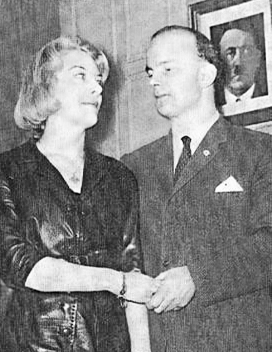
The stab-in-the-back myth was an antisemitic conspiracy theory that was widely believed and promulgated in Germany after 1918. It maintained that the Imperial German Army did not lose World War I on the battlefield, but was instead betrayed by certain citizens on the home front – especially Jews, revolutionary socialists who fomented strikes and labour unrest, and republican politicians who had overthrown the House of Hohenzollern in the German Revolution of 1918–1919. Advocates of the myth denounced the German government leaders who had signed the Armistice of 11 November 1918 as the "November criminals".

Helene Bertha Amalie "Leni" Riefenstahl was a German film director, photographer and actress known for producing Nazi propaganda.

The Great Dictator is a 1940 American anti-war political satire black comedy written, directed, produced, scored by, and starring British comedian Charlie Chaplin, following the tradition of many of his other films. Having been the only Hollywood filmmaker to continue to make silent films well into the period of sound films, Chaplin made this his first true sound film.

The German aircraft carrier Graf Zeppelin was the lead ship in a class of two carriers of the same name ordered by the Kriegsmarine of Nazi Germany. She was the only aircraft carrier launched by Germany and represented part of the Kriegsmarine's attempt to create a well-balanced oceangoing fleet, capable of projecting German naval power far beyond the narrow confines of the Baltic and North Seas. The carrier would have had a complement of 42 fighters and dive bombers.
A big lie is a gross distortion or misrepresentation of the truth primarily used as a political propaganda technique. The German expression was first used by Adolf Hitler in his book Mein Kampf (1925) to describe how people could be induced to believe so colossal a lie because they would not believe that someone "could have the impudence to distort the truth so infamously". Hitler claimed that the technique had been used by Jews to blame Germany's loss in World War I on German general Erich Ludendorff, who was a prominent nationalist political leader in the Weimar Republic.

Stereoscopy is a technique for creating or enhancing the illusion of depth in an image by means of stereopsis for binocular vision. The word stereoscopy derives from Greek στερεός (stereos) 'firm, solid', and σκοπέω (skopeō) 'to look, to see'. Any stereoscopic image is called a stereogram. Originally, stereogram referred to a pair of stereo images which could be viewed using a stereoscope.

Erich Friedrich Wilhelm Ludendorff was a German general, politician and military theorist. He achieved fame during World War I for his central role in the German victories at Liège and Tannenberg in 1914.

The Heinkel He 178 was an experimental aircraft designed and produced by the German aircraft manufacturer Heinkel. It was the world's first aircraft to fly using the thrust from a turbojet engine.

Marie Françoise Suzanne Dior was a French socialite and neo-Nazi underground financier. She was the niece of French fashion designer Christian Dior and Resistance fighter Catherine Dior, who publicly distanced herself from her niece after she married British neo-Nazi activist Colin Jordan in 1963. She was a close friend of Savitri Devi.
Convergence insufficiency is a sensory and neuromuscular anomaly of the binocular vision system, characterized by a reduced ability of the eyes to turn towards each other, or sustain convergence.

German submarine U-1 was the first U-boat built for Nazi Germany's Kriegsmarine following Adolf Hitler's abrogation of the terms of the Treaty of Versailles in 1935, which banned Germany possessing a submarine force.

Esoteric Nazism, also known as Esoteric Fascism or Esoteric Hitlerism, refers to a range of mystical interpretations and adaptations of Nazism. After the Second World War, esoteric interpretations of the Third Reich were adapted into new religious movements of white nationalism and neo-Nazism. Theories suggest that high ranking Nazis believed in the use of Qabalah magic. They included beliefs in finding a mythical Hyperborea.
German submarine U-404 was a Type VIIC U-boat built for Nazi Germany's Kriegsmarine for service during World War II.

Nordstern, sometimes referred to as Neu Drontheim, was a Nazi plan for the creation of a new metropolis located in German-occupied Norway. It was planned to be built in Øysand, 15 km (9.3 mi) southwest of the city of Trondheim, and have a population of around 250,000 to 300,000 German inhabitants.

Hitler: The Rise of Evil is a Canadian television miniseries in two parts, directed by Christian Duguay and produced by Alliance Atlantis. It stars Robert Carlyle in the lead role and explores Adolf Hitler's rise and his early consolidation of power during the years after the First World War and focuses on how the embittered, politically fragmented and economically buffeted state of German society following the war made that ascent possible. The film also focuses on Ernst Hanfstaengl's influence on Hitler's rise to power. The miniseries, which premiered simultaneously in May 2003 on CBC in Canada and CBS in the United States, received two Emmy Awards, for Art Direction and Sound Editing, while Peter O'Toole was nominated for Best Supporting Actor.
German submarine U-612 was a Type VIIC U-boat built for Nazi Germany's Kriegsmarine for service during World War II. She was ordered on 15 August 1940 and laid down at Blohm & Voss, Hamburg, on 21 April 1941. She was launched on 9 January 1942 and commissioned 5 March 1942 Oberleutnant zur See Paul Siegmann was her first commanding officer. He was joined in May 1942 by Herbert Werner, author of the book Iron Coffins, as First Officer.

Stereopsis recovery, also recovery from stereoblindness, is the phenomenon of a stereoblind person gaining partial or full ability of stereo vision (stereopsis).
Susan A. Cotter is a professor of optometry at the Southern California College of Optometry (SCCO) at Marshall B. Ketchum University where she teaches in the classroom and clinic, works with the residents, and conducts clinical researches. Her scientific work is related to related to clinical management strategies for strabismus, amblyopia, non-strabismic binocular vision disorders, and childhood refractive error.
Lynn F. Hellerstein is an American optometrist, speaker and author best known for her work in the field of vision therapy.

Psychopathography of Adolf Hitler is an umbrella term for psychiatric literature that deals with the hypothesis that Adolf Hitler, the leader of Nazi Germany, was mentally ill, although Hitler was never diagnosed with any mental illnesses during his lifetime. Hitler has often been associated with mental disorders such as bipolar disorder, schizophrenia, and psychopathy, both during his lifetime and after his death. Psychiatrists and psychoanalysts who have diagnosed Hitler as having mental disturbance include well-known figures such as Walter C. Langer and Erich Fromm. Other researchers, such as Fritz Redlich, have concluded that Hitler probably did not have these disorders.














